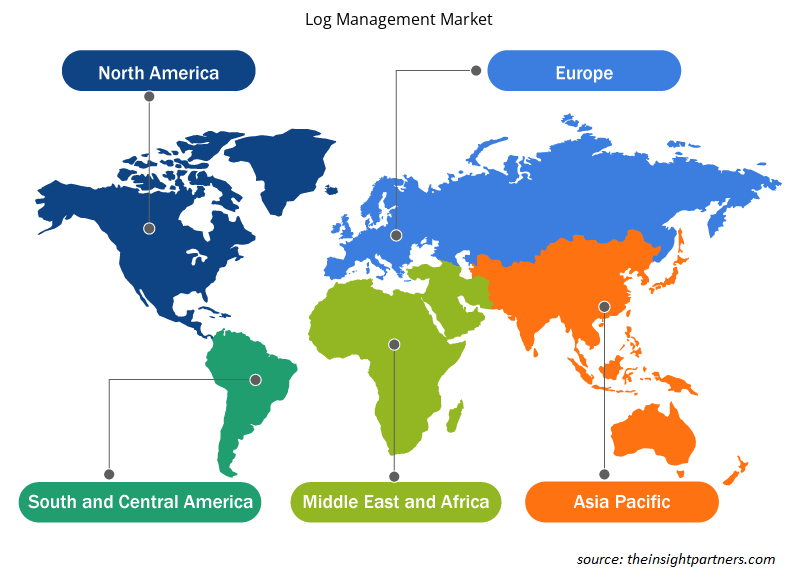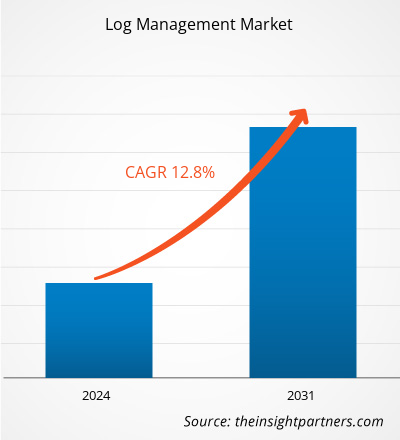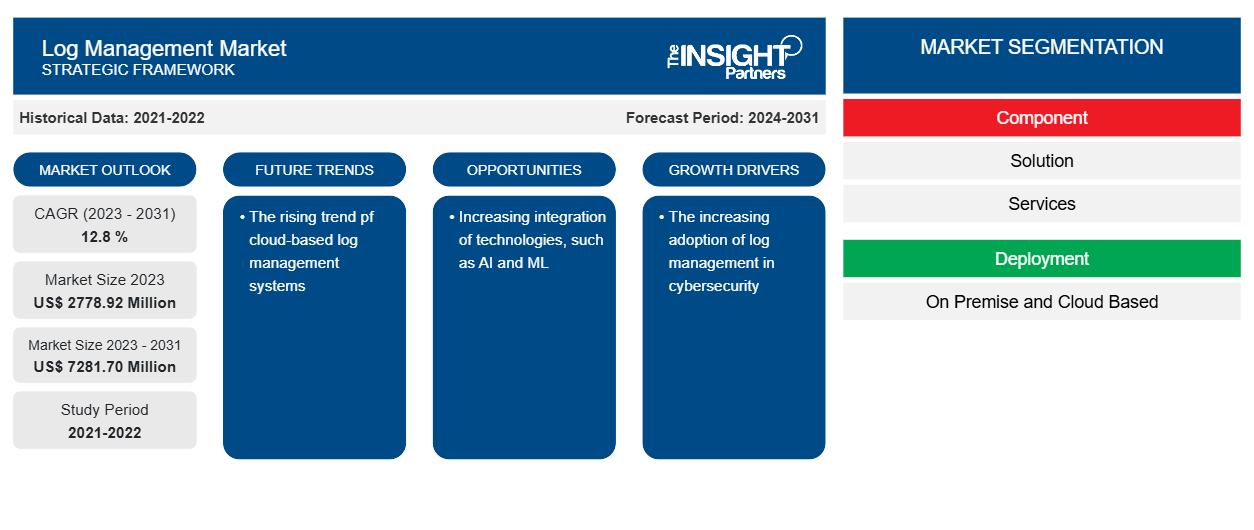Se proyecta que el tamaño del mercado de gestión de registros alcance los 7281,70 millones de dólares estadounidenses en 2031, frente a los 2778,92 millones de dólares estadounidenses en 2023. Se espera que el mercado registre una CAGR del 12,8 % durante el período 2023-2031. Es probable que la tendencia al alza de los sistemas de gestión de registros basados en la nube siga siendo una tendencia clave en el mercado.
Análisis del mercado de gestión de registros
La creciente tendencia de las plataformas de gestión de registros basadas en la nube está impulsando el crecimiento del mercado de gestión de registros debido a su costo y tiempo de implementación simples y reducidos. La plataforma de gestión de registros basada en la nube reduce los gastos de mantenimiento y reparación y mejora la satisfacción del cliente. Por lo tanto, debido a las múltiples ventajas de la plataforma de gestión de registros basada en la nube, la adopción de la plataforma está aumentando para la detección temprana de ciberataques , lo que impulsa el crecimiento del mercado de gestión de registros.
Descripción general del mercado de gestión de registros
La gestión de registros es la práctica de procesar, almacenar, recopilar, analizar y sintetizar continuamente datos de programas y aplicaciones dispares con el fin de mejorar el rendimiento del sistema, administrar mejor los recursos, identificar problemas técnicos, fortalecer la seguridad y mejorar el cumplimiento. Un sistema de gestión de registros ( LMS ) es una solución de software que clasifica, recopila y registra eventos y almacena datos de registros de una variedad de fuentes en una sola ubicación. Los equipos de TI y los profesionales de DevOps y SecOps pueden encontrar un único punto desde el cual recuperar todos los datos relevantes de la red y la aplicación. Por lo general, este archivo de registro se puede buscar e indexar por completo, lo que significa que el equipo de TI puede acceder a los datos que necesita para tomar decisiones sobre el estado de la red, la asignación de recursos o la seguridad.
Personalice este informe según sus necesidades
Obtendrá personalización en cualquier informe, sin cargo, incluidas partes de este informe o análisis a nivel de país, paquete de datos de Excel, así como también grandes ofertas y descuentos para empresas emergentes y universidades.
-
Obtenga las principales tendencias clave del mercado de este informe.Esta muestra GRATUITA incluirá análisis de datos, desde tendencias del mercado hasta estimaciones y pronósticos.
Impulsores y oportunidades del mercado de gestión de registros
La creciente adopción de la gestión de registros en la ciberseguridad
La gestión de registros es un elemento fundamental de la ciberseguridad y las operaciones de TI. Abarca una serie de tareas cruciales destinadas a recopilar, almacenar, analizar y monitorear datos de registros de varios sistemas, aplicaciones y dispositivos dentro de la infraestructura de TI de una organización. Este aspecto de la infraestructura de TI, que a menudo se pasa por alto, es un componente crucial para mantener la seguridad, el rendimiento y el cumplimiento de los activos digitales. Por lo tanto, la creciente adopción de la gestión de registros en la ciberseguridad está impulsando el mercado de la gestión de registros.
Aumento de la integración de tecnologías, como IA y ML
A medida que la tecnología avanza, los equipos de datos pueden aprovechar el poder de la IA y el ML para leer y comprender los archivos de registro. A través de este proceso, pueden indicar fácilmente la causa raíz de un problema del sistema o predecir un error futuro. El aprendizaje automático y la inteligencia artificial a menudo se usan indistintamente con los datos y el análisis predictivo. Sin embargo, el aprendizaje automático es solo un componente de la IA que permite que una máquina aprenda de la experiencia. Cuantos más datos use, mejor será el modelo. Por lo tanto, la creciente integración de tecnologías, como la IA y el ML, está creando más oportunidades para el mercado.
Análisis de segmentación del informe de mercado de gestión de registros
Los segmentos clave que contribuyeron a la derivación del análisis del mercado de gestión de registros son los componentes, la implementación y el tamaño de la organización.
- Según el componente, el mercado de gestión de registros se divide en soluciones y servicios. El segmento de soluciones tuvo una mayor participación de mercado en 2023.
- Por implementación, el mercado se segmenta en local y basado en la nube.
- Por tamaño de la organización, el mercado está segmentado en pequeñas y medianas empresas y grandes empresas.
- Por industria, el mercado está segmentado en TI y telecomunicaciones, BFSI , atención médica , educación, venta minorista y comercio electrónico, y otros.
Análisis de la cuota de mercado de la gestión de registros por geografía
El alcance geográfico del informe del mercado de gestión de registros se divide principalmente en cinco regiones: América del Norte, Asia Pacífico, Europa, Medio Oriente y África, y América del Sur y Central.
América del Norte domina el mercado de gestión de registros. La disponibilidad de plataformas de gestión de registros de código abierto está afectando al mercado general de gestión de registros, ya que restringe la demanda de servicios de gestión de registros pagos. Con la adopción de una plataforma de gestión de registros de código abierto, las empresas también reducen el período de dependencia de un proveedor asociado con una plataforma de gestión de registros paga. Logstash , Fluentd , GoAccess y LOGalyze son plataformas de gestión de registros de código abierto. Por lo tanto, la demanda de sistemas de gestión de registros está aumentando en la región APAC .
Perspectivas regionales del mercado de gestión de registros
Los analistas de Insight Partners explicaron en detalle las tendencias y los factores regionales que influyen en el mercado de gestión de registros durante el período de pronóstico. Esta sección también analiza los segmentos y la geografía del mercado de gestión de registros en América del Norte, Europa, Asia Pacífico, Oriente Medio y África, y América del Sur y Central.

- Obtenga datos regionales específicos para el mercado de gestión de registros
Alcance del informe de mercado de gestión de registros
| Atributo del informe | Detalles |
|---|---|
| Tamaño del mercado en 2023 | US$ 2778,92 millones |
| Tamaño del mercado en 2031 | US$ 7281,70 millones |
| CAGR global (2023 - 2031) | 12,8 % |
| Datos históricos | 2021-2022 |
| Período de pronóstico | 2024-2031 |
| Segmentos cubiertos |
Por componente
|
| Regiones y países cubiertos |
América del norte
|
| Líderes del mercado y perfiles de empresas clave |
|
Densidad de actores del mercado de gestión de registros: comprensión de su impacto en la dinámica empresarial
El mercado de gestión de registros está creciendo rápidamente, impulsado por la creciente demanda de los usuarios finales debido a factores como la evolución de las preferencias de los consumidores, los avances tecnológicos y una mayor conciencia de los beneficios del producto. A medida que aumenta la demanda, las empresas amplían sus ofertas, innovan para satisfacer las necesidades de los consumidores y aprovechan las tendencias emergentes, lo que impulsa aún más el crecimiento del mercado.
La densidad de actores del mercado se refiere a la distribución de las empresas o firmas que operan dentro de un mercado o industria en particular. Indica cuántos competidores (actores del mercado) están presentes en un espacio de mercado determinado en relación con su tamaño o valor total de mercado.
Las principales empresas que operan en el mercado de gestión de registros son:
- Lógica de alerta
- Sistemas Cisco
- Cª
- Corporación IBM
- Perro de datos
- Ritmo logarítmico
Descargo de responsabilidad : Las empresas enumeradas anteriormente no están clasificadas en ningún orden particular.

- Obtenga una descripción general de los principales actores clave del mercado de gestión de registros
Noticias y desarrollos recientes del mercado de gestión de registros
El mercado de gestión de registros se evalúa mediante la recopilación de datos cualitativos y cuantitativos a partir de una investigación primaria y secundaria, que incluye publicaciones corporativas importantes, datos de asociaciones y bases de datos. A continuación, se enumeran algunos de los avances en el mercado de gestión de registros:
- Microsoft lanzó un moderno programa de gestión de registros para ayudar a las agencias federales a acelerar el cumplimiento cibernético (Fuente: Microsoft, comunicado de prensa, febrero de 2022).
- Trimble anunció el lanzamiento de LIMS PRO, una nueva versión alojada en la nube de su ampliamente utilizado sistema de gestión e inventario de troncos (LIMS) para gestionar la adquisición de materia prima de los aserraderos. Como solución de liquidación de troncos basada en la nube, LIMS PRO está diseñado para mejorar la visibilidad operativa de los aserraderos. Permite a las pequeñas y medianas empresas de productos forestales lograr ganancias de productividad y crecimiento que solo las grandes empresas han podido permitirse históricamente mediante la digitalización de los flujos de trabajo de la cadena de suministro de madera. (Fuente: Trimble, comunicado de prensa, julio de 2023)
Informe sobre el mercado de gestión de registros: cobertura y resultados
El informe “Tamaño y pronóstico del mercado de gestión de registros (2021-2031)” proporciona un análisis detallado del mercado que cubre las siguientes áreas:
- Tamaño del mercado de gestión de registros y pronóstico a nivel global, regional y nacional para todos los segmentos clave del mercado cubiertos bajo el alcance
- Tendencias del mercado de gestión de registros, así como dinámicas del mercado, como impulsores, restricciones y oportunidades clave
- Análisis detallado de las cinco fuerzas de Porter y PEST y FODA
- Análisis del mercado de gestión de registros que abarca las tendencias clave del mercado, el marco global y regional, los principales actores, las regulaciones y los desarrollos recientes del mercado.
- Análisis del panorama de la industria y de la competencia que abarca la concentración del mercado, el análisis de mapas de calor, los actores destacados y los desarrollos recientes del mercado de gestión de registros
- Perfiles detallados de empresas
- Análisis histórico (2 años), año base, pronóstico (7 años) con CAGR
- Análisis PEST y FODA
- Tamaño del mercado, valor/volumen: global, regional y nacional
- Industria y panorama competitivo
- Conjunto de datos de Excel
Informes recientes
Informes relacionados
Testimonios
Razón para comprar
- Toma de decisiones informada
- Comprensión de la dinámica del mercado
- Análisis competitivo
- Información sobre clientes
- Pronósticos del mercado
- Mitigación de riesgos
- Planificación estratégica
- Justificación de la inversión
- Identificación de mercados emergentes
- Mejora de las estrategias de marketing
- Impulso de la eficiencia operativa
- Alineación con las tendencias regulatorias























 Obtenga una muestra gratuita para - Mercado de gestión de registros
Obtenga una muestra gratuita para - Mercado de gestión de registros